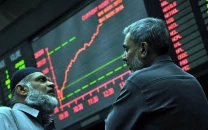Exports rise to 18-month high
Trade deficit shrinks over 40% reaching $1.7 billion in December

Pakistan’s trade deficit contracted by over 40% last month due to a continued tight lid on imports and, for the first time, a better performance in exports in this fiscal year that crossed $2.8 billion – the highest mark in one and a half years.
The trade deficit – the gap between export receipts and import payments – shrank to $1.7 billion in December over a year ago, reported the Pakistan Bureau of Statistics on Tuesday. In absolute terms, there was a $1.1 billion reduction in the deficit – equal to the last International Monetary Fund (IMF) loan tranche – due to a combination of a healthy trend in exports and tight control over imports.
On a year-on-year basis, in December, exports amounted to $2.81 billion, higher by $511 million, or 22.2%, compared to the same month of last year. It was the highest monthly inflow of exports since June 2022 when the country received $2.9 billion. However, Pakistan had not maintained the momentum built in June 2022, and since then, exports were hovering around $2.5 billion on average.
Imports dropped 12.2% and remained in the vicinity of $4.5 billion last month. As a result, the trade deficit narrowed by 40% to $1.7 billion in December. Pakistan has been struggling hard to secure non-debt creating inflows on a sustainable basis aimed at lessening its dependence on foreign debt. The country needs, on average, $25 billion to $30 billion every year, at least for the next three years, to repay the maturing debt and finance the current account deficit.
The foreign exchange reserves remain low, standing at $7.7 billion, on the back of a few major injections by the World Bank and the Asian Development Bank. The IMF is expected to approve the second loan tranche of $700 million next week.
The government has hoped to contain imports to less than $55 billion and to earn $30 billion in exports during the current fiscal year. This still leaves it with a gap of $25 billion to be bridged through foreign remittances. Foreign direct investment has not yet started picking up.
During the first half of the fiscal year, the gap between imports and exports further shrank to $11.1 billion, according to the national data collecting agency. The trade deficit was $5.8 billion or over 34% less than the comparative period of the last fiscal year, it added.
The continued tight control over imports has lessened the pressure on foreign exchange reserves. The low available financing leaves the government with no option but to keep managing international trade.
The IMF has so far not created any issue over the restrictions that Pakistan placed on imports. During the recent review talks, the IMF has cut its projections for the current account deficit and imports. But the latest statistics indicate that imports may now remain even lower than the already downward revised projections by the global lender.
Read Exports increase by 8% in June
During the July-December period, Pakistan imported $26.2 billion worth of goods, down by $5.1 billion, or a little over 16%, compared with the same period last year. Imports during the first six months were equal to only 45% of the new IMF projection of $58.4 billion that it would release next week. The IMF had not accepted the finance ministry’s projection of imports worth $54.5 billion during this fiscal year.
Effectively, every saved dollar through the reduction in imports is taking the pressure off the reserves that still remain at a critical level, equal to only 1.5 months of import cover. The curb on imports does have implications for the country’s economic growth and inflation. The IMF has also lowered the economic growth forecast to 2% for this fiscal year after it remained negative 0.2% in the previous year.
The PBS stated that exports picked up during the July-December period and stood at nearly $15 billion. There was a $740 million increase in exports in six months – slightly more than the next loan tranche that the IMF would approve on January 11th.
The six months’ exports were equal to 49% of the IMF’s downward revised projection of $30.6 billion. On a month-on-month basis, the trade deficit also narrowed down by 13.4%. Exports increased by 9.2% to just over $2.8 billion last month compared to November. Imports remained almost flat at $4.5 billion.
The rupee swings continue post the IMF talks. After peaking at Rs288 to a dollar, it has again started marginally appreciating on a daily basis, and its value has now dropped below Rs282.
Published in The Express Tribune, January 3rd, 2024.
Like Business on Facebook, follow @TribuneBiz on Twitter to stay informed and join in the conversation.



















COMMENTS
Comments are moderated and generally will be posted if they are on-topic and not abusive.
For more information, please see our Comments FAQ